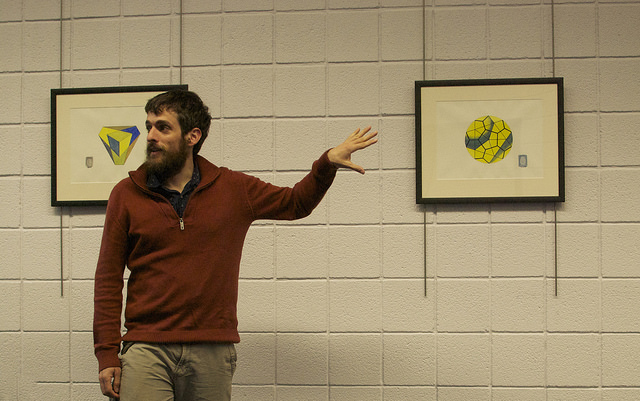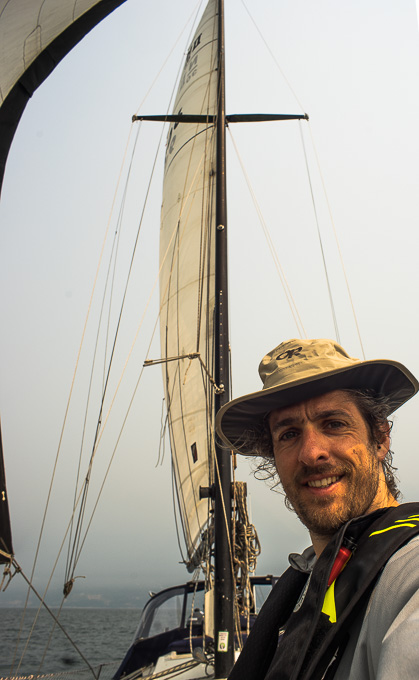
Senior Software Developer and R & D at Copperleaf Technologies
How can an organization prioritize millions of small to large maintenance expenditures over a 50-year period?
I am a Senior Software Developer and Researcher at Copperleaf Technologies in Vancouver, Canada, for Copperleaf’s C55 product. I work primarily with C#, Oracle, and Python. C55 is Copperleaf’s core enterprise product: Premium software that empowers large-scale organizations with Decision Analytics for Asset Investment Planning and Management.
Copperleaf provides solutions that are critical to the effective and safe operation of large infrastructure and utility companies. For example: How can an organization prioritize millions of small to large maintenance expenditures over a 50-year period? How should an organization quantify and mitigate risk? I develop innovative solutions to such problems with a team of developers, designers, and product managers, and then transform those solutions into software products.
I also make stuff, occasionally.
My Academic Side
Over 6 years with 26 co-authors I published 8 journal papers, 9 conference papers, covering topics in combinatorics, theoretical computer science, and networks, and I have several research papers in the pipeline.
I did my graduate degrees at the University of Waterloo and the University of Victoria, followed by a 3-year postdoc at Durham University in the UK.
Much of my research is on datacenter networks and theoretical computer science. I provided the central idea for several of my research group’s major projects and publications on datacenter networks and I take a lead-role in visioning and planning future research paths for our team. I am also a major contributor to the open-source software INRFlow, implemented in C, which we have used for analysing and simulating large-scale datacenter networks.
My research interests include cloud computing, big data, datacenter networks, combinatorial algorithms, computational geometry, graph theory, and tilings and coverings.
As a PhD student I pioneered the area of tatami tilings, the combinatorial geometry problem of laying down square- and domino-shaped tiles such that no four of them touch corners. My work has provided paths to further mathematical discoveries, inspired student projects, and fuelled investigations by other researchers, including Don Knuth. I received over $40,000 in university fellowships and scholarships, and I was nominated by the University of Victoria for one of Canada’s top PhD grants, the Vanier Canadian Graduate Scholarship (CGS).
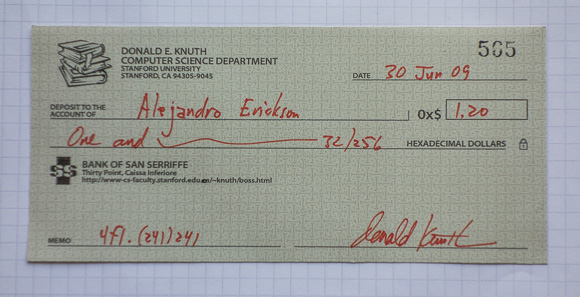
Unrelated to tatami tilings, Don Knuth wrote me a cheque for $2.88.
As a scientist I create and disseminate knowledge. Sharing my discoveries through publications, source code, blog posts, and instructional videos is paramount to my participation in the philosophy that knowledge for the common good must be shared. That’s why promoting math and computer science has been at the centre of my volunteer work.
I created a brand to promote mathematics, and I developed activities and demonstrations that have been experienced by over 5000 participants through over 100 of my own presentations and those of Math Catcher, a math outreach program targeting First Nations, led by multi-award winning educator Prof. Veselin Jungic. I have collected hundreds of thank-you messages from students, teachers, and parents, but here is some of Veselin’s praise:
Writing this reference letter feels bittersweet. On the one hand I feel honoured that I am asked to share with the community my opinion about one extraordinary man that I have had the privilege of calling my student, collaborator, and friend. On the other hand, I am aware that our work in the Math Catcher program is coming to an end and that I am to face a difficult challenge of replacing Mr. Erickson as a member of the Math Catcher team.
I have a 3D printer, with which I created a mechanical realisation of my PhD work.
I make coffee using a 36kg lever espresso machine. It provides 4 or 5 sacred moments every day, where I enter a trance-like state, weighing beans, grinding, levering, timing, watching, and finally sipping the sweet nectar. It’s something of an obsession.
I am married and we have a bilingual son (as far as a 2-year-old is lingual at all).
Alejandro Erickson: Tech Specs
I have been doing research on advanced problems in mathematics, computer science, and networks since 2006.
Ph.D. in Computer Science, University of Victoria, 2013: Monomino-Domino Tatami Coverings.
- Advisor: Professor Frank Ruskey
- External Examiner: Ron Graham (Fellow of the Association for Computing Machinery and the American Mathematical Society)
M.Math, Combinatorics and Optimization, University of Waterloo, 2008: Negative correlation properties for matroids
- Advisor: Prof. David G. Wagner
B.Sc. (hons), Mathematics, Simon Fraser University, 2007
Résumé: EricksonResume.pdf, current as of November 6, 2016. (HTML)
Email: alejandro.erickson@gmail.com
My postdoc positions were at the University of Victoria, with Prof. Frank Ruskey, and at Durham University on the EPSRC grant, “Interconnection Networks: Practice unites with Theory (INPUT)”. INPUT is a multidisciplinary research endeavour headed by Prof. Iain A. Stewart at Durham University and by Prof. Steve Furber (Distinguished Fellow of the British Computer Society) at the University of Manchester.
The highlights of my research with INPUT are:
- A. Erickson, A. E. Kiasari, J. Navaridas, and I. A. Stewart.
An Optimal Single-Path Routing Algorithm in the Datacenter Network DPillar. IEEE Trans. Parallel Distrib. Syst., 2016 (14 pages, to appear). - A. Erickson, J. Pascual Saiz, J. Navaridas, and I. A. Stewart.
Interconnection Networks Research Flow Evaluation Framework (INRFlow). [Software], 2016. - A. Erickson, A. E. Kiasari, J. Navaridas, and I. A. Stewart.
The Stellar Transformation: From Interconnection Networks to Datacenter Networks. Revised version submitted to J. of Computer Networks, 2016. - A. Erickson, A. E. Kiasari, J. Navaridas, and I. A. Stewart.
Bisection Width of Dual-Port, Server-Centric Data Centre Networks. Manuscript in preparation, 2016. - A. Erickson, J. Pascual Saiz, J. Navaridas, and I. A. Stewart.
Routing Algorithms for Recursively-Defined Datacenter Networks. Submitted to IEEE Transactions on Networking, 2016. Previous version in Proc. of Trustcom/BigDataSE/ISPA, 2015 IEEE, 3, 84–91, 2015.
My broader research interests include big data, combinatorial algorithms, computational geometry, datacenter networks, graph theory and applications, tilings and coverings.
Teaching and leadership
I have worked extensively on math and computer science outreach and I have lectured at the undergraduate and (post)graduate levels. In 2015 I worked with The Brilliant Club to deliver a 5-day mini course on my Ph.D. research at a high school in the UK. The results were very positive. I have also worked with Math Catcher in Canada, and led my own initiative, GeoBurst, through which we did mathematical activities with over 1000 students and educators.
I am compelled to share the joys of math and computer science with students, and I believe that doing so is a great benefit to both them and myself.
Read more about me on LinkedIn and browse my personal homepage at alejandroerickson.com.
Refereed Journal Publications
- A. Erickson, A. E. Kiasari, J. Navaridas, and I. A. Stewart.
The Stellar Transformation: From Interconnection Networks to Datacenter Networks. Conditionally accepted in J. of Computer Networks, 2016. - A. Erickson, A. E. Kiasari, J. Navaridas, and I. A. Stewart.
An Optimal Single-Path Routing Algorithm in the Datacenter Network DPillar. IEEE Trans. Parallel Distrib. Syst., 2016 (14 pages, to appear). - E. Chambers, A. Erickson, S. Fekete, J. Lenchner, J. Sember, S. Venkatesh, U. Stege, S. Stolpner, C. Weibel, and S. Whitesides.
Connectivity Graphs of Uncertainty Regions. Algorithmica, 2016 (30 pages). - X. Wang, A. Erickson, J. Fan, and X. Jia.
Hamiltonian Properties of DCell Networks. The Computer Journal, 58(11):2944–2955, 2015. - A. Erickson and M. Schurch.
Monomer-dimer tatami tilings of square regions. Journal of Discrete Algorithms, 16(0):258–269, 2012. - A. Erickson.
Sums of squares and negative correlation for spanning forests of series parallel graphs. The Australasian Journal of Combinatorics, 52:75–89, 2012. - A. Erickson, A. Isgur, B. W. Jackson, F. Ruskey, and S. M. Tanny.
Nested Recurrence Relations with Conolly-like Solutions. SIAM Journal on Discrete Mathematics, 26(1):206–238, 2012. - A. Erickson, F. Ruskey, M. Schurch, and J. Woodcock.
Monomer-Dimer Tatami Tilings of Rectangular Regions. The Electronic Journal of Combinatorics, 18(1):24, 2011.
Refereed Conference Publications
- A. Erickson, A. E. Kiasari, J. Navaridas, and I. A. Stewart.
An efficient shortest-path routing algorithm in the data centre network DPillar. Proc. of the 9th Annual International Conference on Combinatorial Optimization and Applications (COCOA), LNCS, 9486, 209–220, 2015. - A. Erickson, A. E. Kiasari, J. Navaridas, and I. A. Stewart.
Routing Algorithms for Recursively-Defined Data Centre Networks. Trustcom/BigDataSE/ISPA, 2015 IEEE, 3, 84–91, 2015. - A. Erickson and F. Ruskey.
Generating Tatami Coverings Efficiently. Proc. of the international conference Génération Aléatoire de Structures Combinatoires (GASCom), Bertinoro, Italy, 2014. - A. Erickson and F. Ruskey.
Domino Tatami Covering is NP-complete. Proc. of the International Workshop on Combinatorial Algorithms (IWOCA), LNCS, 8288, 140–149, 2013. - A. Erickson.
TatamiMaker: A combinatorially rich mechanical game board. Proc. of the international conference Bridges: Mathematics, Music, Art, Architecture, Culture, 63–70, 2013. - A. Erickson and M. Schurch.
Enumerating Tatami Mat Arrangements of Square Grids. Proc. of the International Workshop on Combinatorial Algorithms (IWOCA), LNCS, 7056, 223–235, 2011. - M. Cheng, E. Delisle, A. Erickson, S. Ganti, F. Mason, N. Vining, and S. Whitesides.
Collaborative problem solving: integrating theory and practice in the classroom. Proc. of the 15th Western Canadian Conference on Computing Education, WCCCE ‘10, 15:1–15:5, 2010. - E. Chambers, A. Erickson, S. Fekete, J. Lenchner, J. Sember, S. Venkatesh, U. Stege, S. Stolpner, C. Weibel, and S. Whitesides.
Connectivity Graphs of Uncertainty Regions. Proc. of the International Symposium on Algorithms and Computation (ISAAC), LNCS, 6507, 434–445, 2010.
Theses
- A. Erickson.
Monomino-Domino Tatami Coverings. Computer Science, University of Victoria, 2013. - A. Erickson.
Negative Correlation Properties for Matroids. Combinatorics and Optimization, University of Waterloo, 2008.
Papers in Preparation or Submitted
- A. Erickson and I. A. Stewart.
The influence of data centre usage on symmetry in datacenter network design. Submitted to Theoretical Computer Science, 2016. - A. Erickson and I. A. Stewart.
Shortest Path Routing in DPillar Datacenter Networks via Cayley Graphs. Manuscript in preparation, 2016. - A. Erickson, J. Pascual Saiz, J. Navaridas, and I. A. Stewart.
Interconnection Networks Research Flow Evaluation Framework (INRFlow). [Software], 2016. - A. Erickson, J. Pascual Saiz, J. Navaridas, and I. A. Stewart.
Bisection Width of Dual-Port, Server-Centric Data Centre Networks. Manuscript in preparation, 2016. - A. Erickson, J. Pascual Saiz, J. Navaridas, and I. A. Stewart.
Multipath Routing in the Datacenter Network DPillar. Manuscript in preparation, 2016. - A. Erickson, J. Pascual Saiz, J. Navaridas, and I. A. Stewart.
Improved Routing in the Data Centre Networks HCN and BCN. Manuscript in preparation, 2016. - A. Erickson, J. Pascual Saiz, J. Navaridas, and I. A. Stewart.
Routing Algorithms for Recursively-Defined Datacenter Networks. Submitted to IEEE Transactions on Networking, 2016. - A. Erickson and F. Ruskey.
Enumerating Maximal Tatami Mat Coverings of Square Grids with $v$ Vertical Dominoes. Manuscript in preparation, 2013.
Other Publications and Art
- A. Erickson.
Five 2-Colourings of the Petersen Graph. Juried art exhibition at Bridges 2014: Mathematics, Music, Art, Architecture, Culture, Seoul, Korea, 2014. - A. Erickson, M. Guay-Paquet, and J. Lenchner.
Zero sumZ: The 7-card challenge. Published online, 2012. - A. Erickson.
Tomoku! 80 Challenging Puzzles. Self Published, 2012. - A. Erickson.
Japanese tatami mat tilings: No four tiles meet. Canadian Mathematical Society Student Committee Quarterly: Notes from the Margin, 2:1–3, 2011.
Pictures
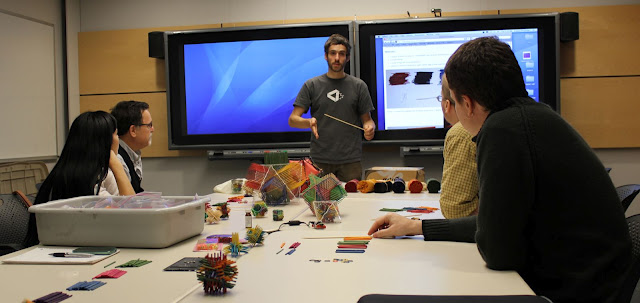
Training Math Catcher volunteers.
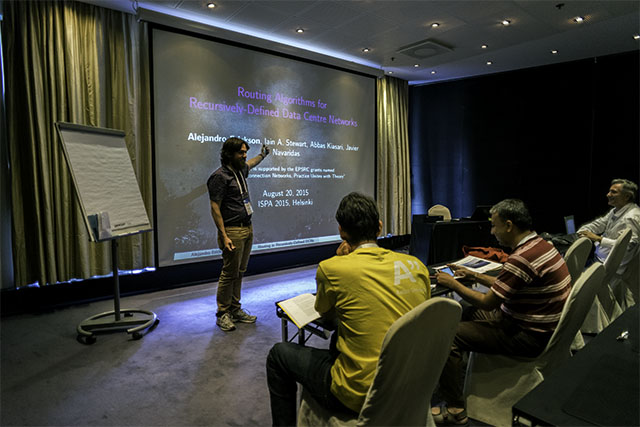
Alejandro Erickson gives a presentation at ISPA in Helsinki in August 2015.
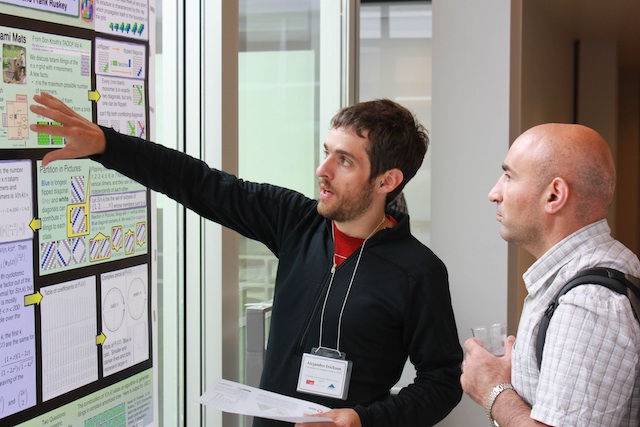
Explaining my research on tatami coverings

My 16-foot tall tensegrity ball c.2012 in Victoria, Canada.

A cheque from Don Knuth
